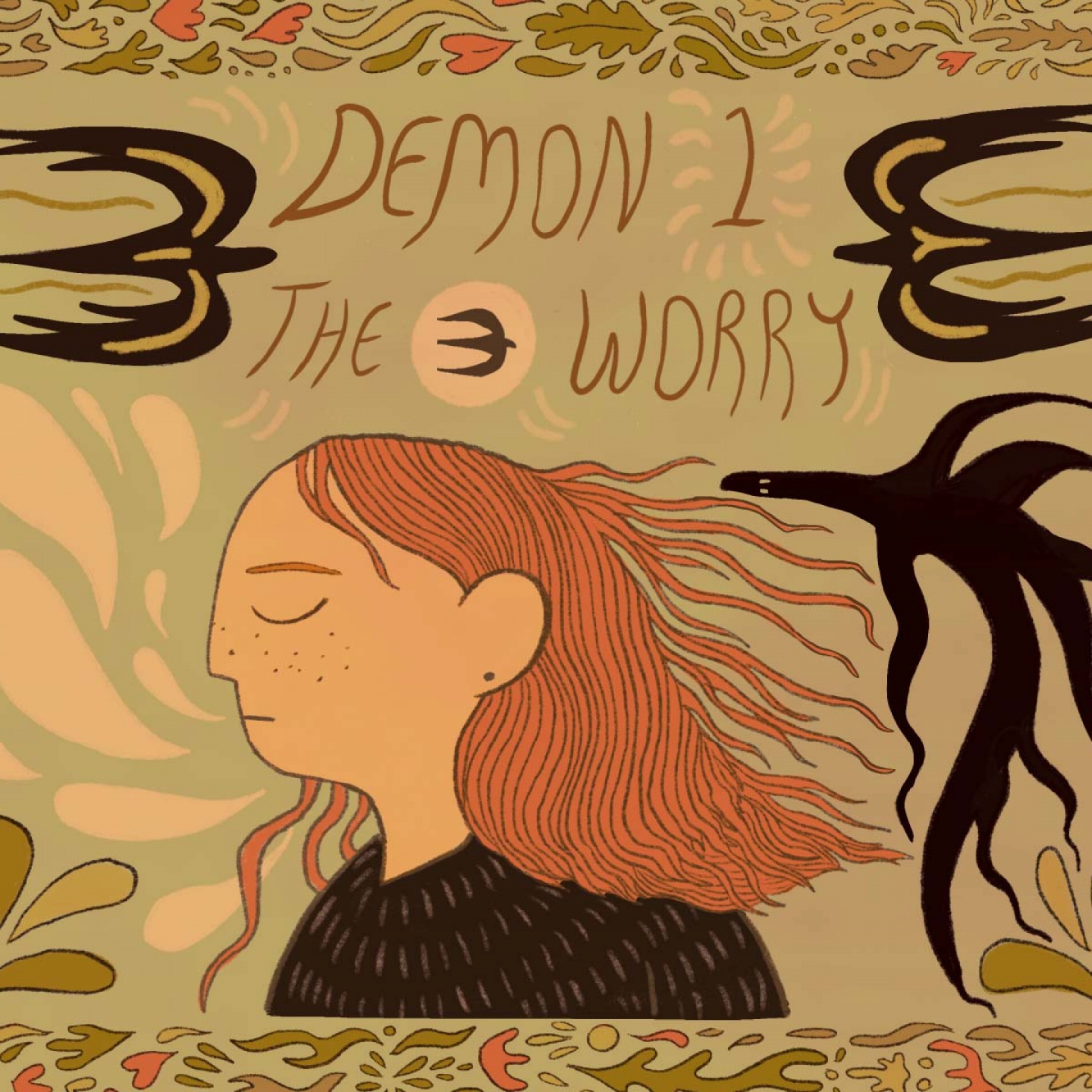When I first read Lynda Barry’s One! Hundred! Demons! a few years back, I remember feeling an impulse to do as the author instructed at the end of the book and ‘Paint my demon!’ but life became busy, and I never got around to it. This project, which required me to draw my own “demon,” felt like a return to that impulse, and when I started, it was like there were demons waiting at the elevator in my mind, briefcases in hand, ready to be exorcized on the page. Reading Lynda Barry’s One! Hundred! Demons! always leaves me feeling inspired in multiple ways, from the beautiful tactility of Barry’s work to the profound emotional depth of her deceptively simple stories. Something always catches onto me and pulls me into her world, leaving me with the desire to create worlds of my own. Reading Barry’s work in this class reminded me just how skilled she is at giving reverence to the little things in life—the intricate details and the strange childhood memories—and yet somehow at the same time, achieving an intense philosophical depth. The micro and macro experiences of growing up are worked into this book masterfully. Barry examines demons that are as everyday as “Dancing” (Barry, 49), and as abstract and enormous as “Lost Worlds” (27).
Barry examines the everyday in a compelling way by incorporating magical thinking into her memories, even when these memories are painful. A moment that seems to rely heavily on this magical thinking is the end of the chapter “Magic Lanterns,” when she considers why we imbue inanimate objects with such emotional significance when we are young: “A book, a blanket, a cloth rabbit. A place on our bed post we liked to touch as we fell asleep. Each with a magic lantern inside capable of conjuring worlds…” (156) I believe conjuring worlds is one of Barry’s special talents, opening up her own memories and stretching them into kaleidoscopes, filling them with questions, humour, and magic.
When considering my own demons, I felt some resistance in my brain, even as those demons seemed pressing. Perhaps this resistance is the mind’s way of protecting us from the things that cause discomfort. I began searching through my memories, trying to find something small, something manageable, something I could wrestle onto the page and be certain I’d get the better of. But nothing specific was jumping out at me. I spent a long time considering possible demons, lining them up like pageant queens, but it wasn’t until I started thinking about one of my bigger demons that any ideas for a comic came to me. This demon is something that affects me every day, something that hides in plain sight in my mind, and yet, it is also something I never talk about. I felt like the spirit of what Lynda Barry did with One! Hundred! Demons! was about facing her life and experience with courage, and so I decided to attempt to write about the demon that required the most courage: my anxiety.
One of the things that really inspired me about Barry’s autography was its ability to play with the parameters of reality. While the comics are about real experiences, Barry isn’t afraid to get abstract with the way she chooses to depict or write about these experiences. Like in the chapter “Cicadas” (158), Barry visualizes her feelings about her friend’s suicide in abstract ways, depicting a haunting, eyeless figure looming throughout the chapter. Barry is able to personify her demons, as well as visually express them. I decided to try to do the same, although I took it in a slightly different direction, leaning more on fantasy than anecdotal depictions.
When designing my demon, I decided to warm up by drawing bird silhouettes. Bird silhouettes are one of my favourite things to draw. They appear in a lot of my work, and drawing them gives me a profound sense of comfort and equilibrium. The technique of “warming up” in the margins is one that Barry herself uses, in order to get started when she feels stuck. As I was drawing my birds, I wondered what would happen if I corrupted one slightly, rendered it spindly and haunting. For my demon, I wanted to take something that usually brings me comfort, and invert it, showing the shadow-side of my experiences. I decided to make the demon into a visual element, that would appear throughout my comic, because it felt right to illustrate a concept like anxiety by giving it some physical presence. As I worked on my comic I thought about my experience reading One! Hundred! Demons! and about how cathartic it can be to make work about something that has brought and brings you pain.
When I first finished my comic, I had this strange sense that I had somehow done it wrong. Maybe I hadn’t included enough of reality in it? Maybe it was too different from Barry’s work to be inspired by it? But ultimately, I decided that the point of this exercise was to use another artist’s work as a jumping-off point, and that there are so many ways to tell your story. That is one of the best parts about autography. It is your story, and so it is likely you’re the only one who knows how to tell it. We all have so many stories inside of us, our memories and experiences encapsulated in our bodies. Sometimes it is important to feel a sense of emotional release, and while this can come from a variety of outlets, there is something special about using comics to do this. I am grateful to have had the chance to organize my thought and emotions visually, and I am grateful to Lynda Barry, for inspiring me to confront my demons with my favorite weapon: the pen.

Brooklin Holbrough
Brooklin Holbrough is an artist, illustrator, and writer based in Peterborough Ontario, her hometown. A recent graduate with from OCAD University’s illustration program, Brooklin is a freelance illustrator, a passionate Peterborough resident, and a believer in dragons. Brooklin is extremely curious about the world and seeks out opportunities for magic to happen; it is this passion that drives her work. Her current focus is on children’s media, including picture books and graphic novels. Brooklin enjoys exploring the many ways mythology has shaped our realities, and this was the subject of her recent thesis project at OCADU.
Works Cited & Consulted
- Barry, Lynda. One Hundred Demons. Drawn & Quarterly, 2017.
Header Photo by Brooklin Holbrough. The Worry, 2021.
